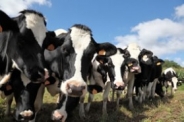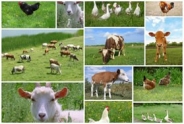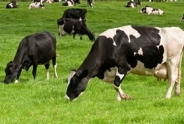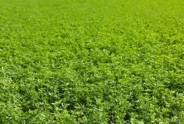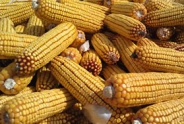Precision Ag
Precision agricultural practices continue to be more widely adopted each year by western New York farmers in order to increase yields, reduce fertilizer, chemical, and labor costs, and protect the environment. Many practices are part of precision agriculture. Soil sampling based on small grids (0.5-5 acres), soil types, or soil management zones allows farmers to vary their rates of lime and fertilizer applications along with seeding rates of corn and soybeans to capture more yield on the productive areas and conserve resources on less productive sections of their fields. Traditional probe sampling, electrical conductivity, and on-the-go sensors are used for precision soil sampling. Auto-guidance systems greatly improve the efficiency of chemical applications, fertilizer applications, and seeding patterns by reducing overlaps, eliminating gaps, and reducing operator fatigue. Yield monitors allow farmers to further refine their management by accurately recording the yield variations across management zones in each field. Satellite imagery, aerial photography, tool-bar mounted cameras and sensors, and agricultural drones (UAVs) provide additional tools to map and monitor soil variation and crop progression. The NWNY Dairy, Livestock, and Field Crops Team continues to support the adoption of precision agricultural practices through educational programming in partnership with the Wyoming County Dairy Institute, work with industry representatives, and on-farm research of new technologies. Throughout northwestern New York precision agricultural services and equipment are provided by, but not limited to, Growmark FS, Monroe Tractor, Agrinetix LLC, Fingerlakes Agronomics Inc, BCA Ag Technologies, Oxbo, and Western New York Crop Management Association.
Mike Stanyard, Field Crops & IPM Specialist

John Hanchar, Farm Business Management Specialist

Auto Section Control (ASC) is a precision agriculture technology designed to reduce double planting and other crop input usage in headlands. See the presentation by Erick Haas and John Hanchar at the 2017 Operations Managers Conference for benefits and costs, including results from partial budgeting and capital investment analysis.
John Hanchar, Farm Business Management Specialist

Two benefits attributed to auto steer mentioned frequently by producers and their advisors are reduced stress and reduced fatigue. Combine these benefits with expected favorable economic and financial impacts, and auto steer has the potential to be a beneficial change in practice for farmers, one that farmers will likely want to evaluate for their business.
Mike Stanyard, Field Crops & IPM Specialist

Survey and report by Kevin Kreher (kmk279@cornell.edu)
This work was commissioned by Cornell Cooperative Extension of Genesee County and the NWNY Dairy, Livestock and Field Crops Team to determine how many growers are using technology, gauge how it is working for them, and discover how Cornell Cooperative Extension might help farmers working with these technologies. More than 60 people were interviewed for this report, encompassing the perspectives of growers, consultants, industry experts, dealers, and equipment manufacturers. The growers portion of this survey represented almost 140 thousand acres of cropland in the region.
Mike Stanyard, Field Crops & IPM Specialist

Tune in as the NWNY Teams' Extension agronomists put on their GoPro cameras and head to the field.
Bill Verbeten, Field Crops

Considering varying your corn or soybean populations? Curious about multiple hybrid planters and planting two corn or soybean varieties in the same field? Maybe you're trying to decide between a planter with hydraulic or air bag down force pressure? If so check out this AgFocus Newsletter article from April of 2015.
Bill Verbeten, Field Crops

On Sunday February 15th, 2015 the FAA released it's proposed rules for commercial unmanned aerial systems (UAS), commonly called drones, for public comment for 60 days. A summary can be found in the PDF below.
Bill Verbeten, Field Crops

Have a question about using an unmanned aerial system (UAS) on your farm? Not sure what is and isn't legal for drone use on your land? Check out this PDF for more information.
Bill Verbeten, Field Crops

Farmers and agronomists are constantly looking for better tools to improve crop production, and corn nitrogen is no exception. In an effort to account for the spatial variability within every field and the temporal variability of nitrogen due to weather farmers are beginning to use two new tools, GreenSeeker and Adapt-N, on a small scale in northwestern NY. While these tools have great potential to improve corn nitrogen management it is important to understand what they require to work well and the situations where their use may not be warranted until more experience is gained with them. Download the PDF for the full article that appeared in the June 2014 Ag Focus Newsletter.
Bill Verbeten, Field Crops

An expanded version of the February 2014 Ag Focus Article, Variable Rate Fertility Management.
Bill Verbeten, Field Crops

Interested in the Adapt N tool? Check out the videos, PDFs, and manual below.
Bill Verbeten, Field Crops

Interested in creating soil management zones with soil conductivity on your farm? Download this PDF.
Nancy Glazier, Small Farms & Livestock Specialist
List of some apps for smartphone users.
Bill Verbeten, Field Crops

Nancy Glazier, Small Farms & Livestock Specialist
A serious and potentially hazardous situation can occur when farms using gypsum as bedding agitate their long term manure storages.
Bill Verbeten, Field Crops
Ready to start understanding the nuts and bolts of precision agriculture guidance systems? Continuously Operating Reference Stations (CORS) are a critical part of how the precision agriculture system works. Be sure to check this PDF from Alabama Cooperative Extension describing how CORS work. Also take a look at NOAA's website with maps of CORS locations across the United States (and the rest of the world) and downloadable data http://www.ngs.noaa.gov/CORS/.
Bill Verbeten, Field Crops
Is precision ag for your farm? Heard about neighbors making some serious money (or having some serious headaches) because of precision ag? This PDF from Alabama Cooperative Extension gives a good overview of how to start planning to include precision agriculture practices on your farm.
Bill Verbeten, Field Crops
Do you want to a get quick gain from precision ag technology? Consider installing tramlines. This PDF from Alabama Cooperative Extension discusses the basics of tramlines and how to modify your equipment to put them in place on your farm.
Crop Alert
Mike Stanyard, Field Crops & IPM Specialist
Northwest New York Dairy, Livestock & Field Crops
Last Modified: July 27, 2018

Timely observations, information, and control strategies for managing pests, fertility, and current conditions on northwestern NY farms.
Benefits and Costs of Entry Level Precision Agriculture Technologies
John Hanchar, Farm Business Management Specialist
Northwest New York Dairy, Livestock & Field Crops
Last Modified: February 16, 2017

Auto Section Control (ASC) is a precision agriculture technology designed to reduce double planting and other crop input usage in headlands. See the presentation by Erick Haas and John Hanchar at the 2017 Operations Managers Conference for benefits and costs, including results from partial budgeting and capital investment analysis.
Entry Point Precision Ag Technology: Benefits & Costs for Decision Making
John Hanchar, Farm Business Management Specialist
Northwest New York Dairy, Livestock & Field Crops
Last Modified: March 15, 2016

Two benefits attributed to auto steer mentioned frequently by producers and their advisors are reduced stress and reduced fatigue. Combine these benefits with expected favorable economic and financial impacts, and auto steer has the potential to be a beneficial change in practice for farmers, one that farmers will likely want to evaluate for their business.
Precision Agriculture Adoption and Trends in Western New York
Mike Stanyard, Field Crops & IPM Specialist
Northwest New York Dairy, Livestock & Field Crops
Last Modified: October 21, 2015

Survey and report by Kevin Kreher (kmk279@cornell.edu)
This work was commissioned by Cornell Cooperative Extension of Genesee County and the NWNY Dairy, Livestock and Field Crops Team to determine how many growers are using technology, gauge how it is working for them, and discover how Cornell Cooperative Extension might help farmers working with these technologies. More than 60 people were interviewed for this report, encompassing the perspectives of growers, consultants, industry experts, dealers, and equipment manufacturers. The growers portion of this survey represented almost 140 thousand acres of cropland in the region.
Crop Cam
Mike Stanyard, Field Crops & IPM Specialist
Northwest New York Dairy, Livestock & Field Crops
Last Modified: September 9, 2015

Tune in as the NWNY Teams' Extension agronomists put on their GoPro cameras and head to the field.
Crop Cam 9-01-15 White Mold in Soybeans, Mike Stanyard in Ontario County.
Crop Cam 6-17-15 Scouting Soybean Aphids Mike Stanyard in Ontario County.
Crop Cam 6-05-15 Scouting Black Cutworm in Field Corn Mike Stanyard in Orleans County.
Crop Cam 5-29-15 Identifying Flowering Stage of Wheat Mike Stanyard in Monroe County.
Crop Cam 5-15-15 Alfalfa Weevil Larvae Scouting Mike Stanyard in Ontario County.
Crop Cam 5-14-15 Winter Triticale Forage Harvest Mike Stanyard in Wayne County.
Crop Cam 4-27-15:Comparing two winter malting barley fields. Bill Verbeten in Niagara County.
Crop Cam 4-6-15: Estimating wheat tiller counts per square yard. Mike Stanyard in Ontario County.
Crop Cam 3-20-15:Evaluating winter malting barley. Bill Verbeten in Niagara County.
Varying Corn & Soybean Populations, Varieties, & Down Force
Bill Verbeten, Field Crops
Northwest New York Dairy, Livestock & Field Crops
Last Modified: March 18, 2015

Considering varying your corn or soybean populations? Curious about multiple hybrid planters and planting two corn or soybean varieties in the same field? Maybe you're trying to decide between a planter with hydraulic or air bag down force pressure? If so check out this AgFocus Newsletter article from April of 2015.
Proposed FAA Drone Rules Released
Bill Verbeten, Field Crops
Northwest New York Dairy, Livestock & Field Crops
Last Modified: February 24, 2015

On Sunday February 15th, 2015 the FAA released it's proposed rules for commercial unmanned aerial systems (UAS), commonly called drones, for public comment for 60 days. A summary can be found in the PDF below.
FAQs about Farm Drones
Bill Verbeten, Field Crops
Northwest New York Dairy, Livestock & Field Crops
Last Modified: December 22, 2014

Have a question about using an unmanned aerial system (UAS) on your farm? Not sure what is and isn't legal for drone use on your land? Check out this PDF for more information.
New Technology for Corn Nitrogen Needs
Bill Verbeten, Field Crops
Northwest New York Dairy, Livestock & Field Crops
Last Modified: June 20, 2014

Farmers and agronomists are constantly looking for better tools to improve crop production, and corn nitrogen is no exception. In an effort to account for the spatial variability within every field and the temporal variability of nitrogen due to weather farmers are beginning to use two new tools, GreenSeeker and Adapt-N, on a small scale in northwestern NY. While these tools have great potential to improve corn nitrogen management it is important to understand what they require to work well and the situations where their use may not be warranted until more experience is gained with them. Download the PDF for the full article that appeared in the June 2014 Ag Focus Newsletter.
Variable Rate Fertility Management
Bill Verbeten, Field Crops
Northwest New York Dairy, Livestock & Field Crops
Last Modified: April 24, 2014

An expanded version of the February 2014 Ag Focus Article, Variable Rate Fertility Management.
Adapt N Training Resources
Bill Verbeten, Field Crops
Northwest New York Dairy, Livestock & Field Crops
Last Modified: April 15, 2014

Interested in the Adapt N tool? Check out the videos, PDFs, and manual below.
Mapping Management Zones with Soil Conductivity
Bill Verbeten, Field Crops
Northwest New York Dairy, Livestock & Field Crops
Last Modified: February 4, 2014

Interested in creating soil management zones with soil conductivity on your farm? Download this PDF.
Apps for Ag
Nancy Glazier, Small Farms & Livestock Specialist
Northwest New York Dairy, Livestock & Field Crops
Last Modified: December 20, 2013
List of some apps for smartphone users.
Veris Soil Electrical Conductivity, pH, & OM Videos
Bill Verbeten, Field Crops
Northwest New York Dairy, Livestock & Field Crops
Last Modified: December 17, 2013

Gypsum Bedding in Long-Term Manure Storage May Create Dangerous Conditions
Nancy Glazier, Small Farms & Livestock Specialist
Northwest New York Dairy, Livestock & Field Crops
Last Modified: October 17, 2013
A serious and potentially hazardous situation can occur when farms using gypsum as bedding agitate their long term manure storages.
Application of CORS in Agriculture
Bill Verbeten, Field Crops
Northwest New York Dairy, Livestock & Field Crops
Last Modified: June 14, 2013
Ready to start understanding the nuts and bolts of precision agriculture guidance systems? Continuously Operating Reference Stations (CORS) are a critical part of how the precision agriculture system works. Be sure to check this PDF from Alabama Cooperative Extension describing how CORS work. Also take a look at NOAA's website with maps of CORS locations across the United States (and the rest of the world) and downloadable data http://www.ngs.noaa.gov/CORS/.
Considerations for Adopting & Implementing Precision Ag Technologies
Bill Verbeten, Field Crops
Northwest New York Dairy, Livestock & Field Crops
Last Modified: June 14, 2013
Is precision ag for your farm? Heard about neighbors making some serious money (or having some serious headaches) because of precision ag? This PDF from Alabama Cooperative Extension gives a good overview of how to start planning to include precision agriculture practices on your farm.
Tramlines
Bill Verbeten, Field Crops
Northwest New York Dairy, Livestock & Field Crops
Last Modified: June 14, 2013
Do you want to a get quick gain from precision ag technology? Consider installing tramlines. This PDF from Alabama Cooperative Extension discusses the basics of tramlines and how to modify your equipment to put them in place on your farm.
Upcoming Events
2026 Corn Congress
January 14, 2026
Henrietta, NY
Participant Registration for the 2026 Corn Congress NOW OPEN!
NOW OFFERING 1.5 DEC Recertification CREDITS
2026 Forage Congress
January 28, 2026
Nunda, NY
Register to attend 2026 Forage Congress!
2026 NWNY Dairy Day
February 5, 2026 : NWNY Dairy Day 2026
Perry, NY
Sponsorship and Registration OPEN!
The CCE NWNY Dairy, Livestock and Field Crops team will be holding it's 4th Annual "Dairy Day" on February 5, 2026! We will be bringing the latest in dairy research and hot topics to you with this in-person, 1-day conference.
Announcements
The NWNY Team is Hiring!
The NWNY Dairy, Livestock and Field Crops Team is currently looking for an Area Dairy Management Specialist as well as a Small Farms and Livestock Specialist:The full position descriptions and instructions on how to apply are available here:
Area Dairy Management Specialist: https://academicjobsonline.org/ajo/jobs/31178
Small Farms and Livestock Specialist: https://academicjobsonline.org/ajo/jobs/30979
Follow us on Instagram
See photos and reels of our most recent events and programs!Join us on Facebook!
Follow us on Facebook to get up to date posts about events, workshops and everything NWNY!Add us on LinkedIn!
Connect with us on LinkedIn to get more information about upcoming workshops and programs!

